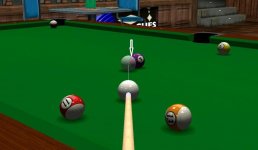When the CB is aimed at the edge of the OB, the balls overlap. The overlap puts the centers of both balls in line with their outside edges.
This overlap takes on the shape of a football. The exact center of this overlapping football shape is where the 2 balls contact each other.
Aim the CB center at the outer edge of the OB, and the contact point is halfway from the OB verticle centerline. When this football shape
becomes wider or narrower, both balls still contact in the center. Wherever the center CB is aimed, contact is halfway from the OB center.
So let's review what's happening... Aim the CB center to hit the OB exactly on center... and it goes straight.
Aim the CB center to hit the OB edge... and it hits halfway between the OB edge and the OB verticle center.
If the Overlap Contact Point is always halfway the distance from the OB center, why not use the contact point for aiming.
If the OB pocketing contact point is 1/4" from the OB verticle center, aim the center of the CB 1/4" past the contact point.
Aim the CB to hit the OB full in the face. Look at the distance between the pocketing contact point to the OB centerline.
Aim the CB center to hit an equal distance past the OB pocketing point. The OB will be hit on the overlap contact point.
I try to find the contact point for pocketing by visualizing the tangent line running horizontally across the back of the OB.
Just another amongst the long list of aiming suggestions... Flame on
.
This overlap takes on the shape of a football. The exact center of this overlapping football shape is where the 2 balls contact each other.
Aim the CB center at the outer edge of the OB, and the contact point is halfway from the OB verticle centerline. When this football shape
becomes wider or narrower, both balls still contact in the center. Wherever the center CB is aimed, contact is halfway from the OB center.
So let's review what's happening... Aim the CB center to hit the OB exactly on center... and it goes straight.
Aim the CB center to hit the OB edge... and it hits halfway between the OB edge and the OB verticle center.
If the Overlap Contact Point is always halfway the distance from the OB center, why not use the contact point for aiming.
If the OB pocketing contact point is 1/4" from the OB verticle center, aim the center of the CB 1/4" past the contact point.
Aim the CB to hit the OB full in the face. Look at the distance between the pocketing contact point to the OB centerline.
Aim the CB center to hit an equal distance past the OB pocketing point. The OB will be hit on the overlap contact point.
I try to find the contact point for pocketing by visualizing the tangent line running horizontally across the back of the OB.
Just another amongst the long list of aiming suggestions... Flame on
.
Last edited:
